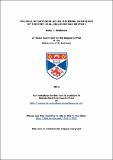Files in this item
The role of oxytocin in the maternal behaviour of the grey seal (Halichoerus grypus)
Item metadata
| dc.contributor.advisor | Pomeroy, Patrick P. | |
| dc.contributor.advisor | Hazon, N. (Neil) | |
| dc.contributor.advisor | Twiss, Sean D. | |
| dc.contributor.author | Robinson, Kelly J. | |
| dc.coverage.spatial | 238 | en_US |
| dc.date.accessioned | 2015-07-28T14:37:06Z | |
| dc.date.available | 2015-07-28T14:37:06Z | |
| dc.date.issued | 2014-12 | |
| dc.identifier.uri | https://hdl.handle.net/10023/7057 | |
| dc.description.abstract | The neuropeptide hormone oxytocin plays an integral role in mammalian reproductive endocrinology and behaviour. It has been utilised to study the physiological factors driving maternal behaviour in both laboratory and domestic mammals, but few studies have successfully detected oxytocin in wild individuals, or linked detected concentrations to the behaviours they exhibit. Phocid seals present an excellent system in which to study oxytocin’s effects on maternal behaviour in the wild. The energetic constraints placed on a phocid mother during the dependant period should cause strong selection pressure for behaviour that maximises reproductive success with the least cost to the mother. However in many phocid species, substantial variations in maternal behaviour persist. In order to investigate whether oxytocin plays a role in driving this variation, behavioural and hormonal datasets were collected from grey seal mothers and pups on two breeding colonies in Scotland. A protocol for the detection of plasma oxytocin in phocid seals was successfully developed, along with the methodology to manipulate peripheral oxytocin concentrations to directly test the hormone’s impact on behaviour. Both correlatory studies on natural oxytocin concentrations and behaviour in wild mother-pup pairs and manipulation experiments on newly weaned pups show that plasma oxytocin concentrations influence behaviours that makes mother – pup separation less likely. These include increasing the time spent in close proximity to each other, increasing the number of checks performed on the pup and reducing the aggressive behaviour directed towards the other individual. Additionally, plasma oxytocin could be used as an indicator of weak maternal bonds between mother and pup, which resulted in behaviours such as abandonment and fostering. This study highlights the potential of oxytocin for studying variations in behaviours critical to an individual’s reproductive success and provides the methodological framework for studies on other wild species to be conducted in the future. | en_US |
| dc.language.iso | en | en_US |
| dc.publisher | University of St Andrews | |
| dc.rights | Creative Commons Attribution-NonCommercial-NoDerivatives 4.0 International | |
| dc.rights.uri | http://creativecommons.org/licenses/by-nc-nd/4.0/ | |
| dc.subject | Oxytocin | en_US |
| dc.subject | Maternal behaviour | en_US |
| dc.subject | Seal | en_US |
| dc.subject | Hormones | en_US |
| dc.subject | Social recognition | en_US |
| dc.subject | Marine mammal | en_US |
| dc.subject.lcc | QL737.P64R7 | |
| dc.subject.lcsh | Gray seal--Behavior | en_US |
| dc.subject.lcsh | Parental behavior in animals | en_US |
| dc.subject.lcsh | Social behavior in animals | en_US |
| dc.subject.lcsh | Oxytocin--Research | en_US |
| dc.title | The role of oxytocin in the maternal behaviour of the grey seal (Halichoerus grypus) | en_US |
| dc.type | Thesis | en_US |
| dc.contributor.sponsor | Natural Environment Research Council (NERC) | en_US |
| dc.contributor.sponsor | SMRU Marine | en_US |
| dc.type.qualificationlevel | Doctoral | en_US |
| dc.type.qualificationname | PhD Doctor of Philosophy | en_US |
| dc.publisher.institution | The University of St Andrews | en_US |
This item appears in the following Collection(s)
Except where otherwise noted within the work, this item's licence for re-use is described as Creative Commons Attribution-NonCommercial-NoDerivatives 4.0 International
Items in the St Andrews Research Repository are protected by copyright, with all rights reserved, unless otherwise indicated.


